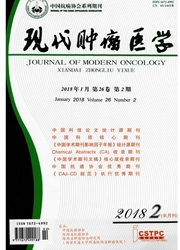

 中文摘要:
中文摘要:
目的:前期研究发现转染Axin能抑制A549细胞的增殖能力,本研究目的是探讨Axin抑制A549细胞增殖能力的机制。方法:我们构建了野生型和突变型Axin质粒(Axin与β-catenin结合位点剪切突变)转染A549细胞,并应用GSK-3BsiRNA处理细胞,Westernbolt检测各处理组β-catenin和cyclinD1的变化,MTT检测各处理组细胞增殖能力的变化。结果:转染野生型Axin能够明显地下调β-catenin和cyclin D1(P〈0.01),抑制Wnt通路活性和A549细胞的增殖(P〈0.01),而GSK-3BsiRNA可以阻断Axin的这种功能;转染突变型Axin不能有效的下调Wnt通路或A549细胞的增殖能力。结论:Axin主要是通过负向调控wnt通路抑制A549细胞的增殖。Axin可能成为未来治疗肺癌的新靶点。
 英文摘要:
英文摘要:
Objective: We found that transfection of Axin could inhibit the proliferation of A549 cells, but the ex- act mechanism is unclear. Methods: We constructed wild - type Axin plasmid, Axin mutant ( β - catenin binding site shear mutation) and GSK- 3β siRNA to treat A549, Western blot was used to detect the expression of β -catenin and cyclin D1. MTT was used to study the change of proliferation. Results: Transfection of wild - type Axin down - regulated β -catenin and cyclin D1 (P 〈 0.05 ) and negatively regulated Wnt pathway and the proliferation of A549. GSK - 3β siRNA could block this function of Axin. Transfection of Axin mutant could not down - regulate Wnt path- way or the proliferation of A549. Conclusion:Axin inhibits the proliferation of 3.549 cells mainly through negatively regulating Wnt signaling. Axin may become a new target for clinical treatment of lung cancer.
 同期刊论文项目
同期刊论文项目
 同项目期刊论文
同项目期刊论文
 Leucine zipper tumor suppressor 2 inhibits cell proliferation and regulates Lef/Tcf-dependent transc
Leucine zipper tumor suppressor 2 inhibits cell proliferation and regulates Lef/Tcf-dependent transc Expression of metastasis-associated protein 2 (MTA2) might predict proliferation in non-small cell l
Expression of metastasis-associated protein 2 (MTA2) might predict proliferation in non-small cell l Expression of Frat1 correlates with expression of beta-catenin and is associated with a poor clinica
Expression of Frat1 correlates with expression of beta-catenin and is associated with a poor clinica Overexpression of small GTPases directly correlates with expression of delta-catenin and their coexp
Overexpression of small GTPases directly correlates with expression of delta-catenin and their coexp Ataxia-telangiectasia group D complementing gene (ATDC) promotes lung cancer cell proliferation by a
Ataxia-telangiectasia group D complementing gene (ATDC) promotes lung cancer cell proliferation by a Overexpression of Frat1 correlates with malignant phenotype and advanced stage in human non-small ce
Overexpression of Frat1 correlates with malignant phenotype and advanced stage in human non-small ce P120-Catenin Isoforms 1 and 3 Regulate Proliferation and Cell Cycle of Lung Cancer Cells via beta-Ca
P120-Catenin Isoforms 1 and 3 Regulate Proliferation and Cell Cycle of Lung Cancer Cells via beta-Ca Clinicopathological significance of cathepsin D expression in non-small cell lung cancer is conditio
Clinicopathological significance of cathepsin D expression in non-small cell lung cancer is conditio Diversin increases the proliferation and invasion ability of non-small-cell lung cancer cells via JN
Diversin increases the proliferation and invasion ability of non-small-cell lung cancer cells via JN Ataxia-telangiectasia group D complementing gene (ATDC) upregulates matrix metalloproteinase 9 (MMP-
Ataxia-telangiectasia group D complementing gene (ATDC) upregulates matrix metalloproteinase 9 (MMP- 期刊信息
期刊信息
